|
Happy Independence Day! For whatever reason, July 4th is National Barbecued Spareribs Day (we’re partial to the alternate, more elegant, spelling, spare ribs).
What’s the difference between spare ribs and baby back ribs? Not a whole lot: They’re just two different pieces of the same slab of meat.
The main difference is size. The farther down the rib cage you go, the meatier the ribs become.
THE DIFFERENT TYPES OF RIBS
Spare ribs (left side of photo #3) are cut from the bottom of the rib cage, the belly side below the back ribs, which extend about 6″ down from the spine. They are longer and flatter than baby back ribs. Compared to baby back ribs, spare ribs have more meat between the bones and less meat on top of them; but overall, they are meatier than other types of ribs. The meat is more marbled, and the greater proportion of fat makes them more tender than baby back ribs. In addition to the alternate spelling spareribs, they are also called side ribs.
Boneless spare ribs are not deboned spare ribs. Rather, they’re made from a boneless pork butt, the shoulder of the pig. The pork is cut into thick slices, roasted, and then cut into long thin lengths to resemble boneless spare ribs.
St. Louis-style ribs, also known as St. Louis cut ribs, start off as spare ribs. But they’re trimmed down to a rectangular shape that’s more uniform and easier to eat. Most ribs called spare ribs are actually St. Louis-cut. But for the purpose of this article, we’re calling them spare ribs, a better-known term in much of the country. The National Pork Board says that St. Louis-style ribs are a squared cut. Square or rectangular, they are straight and flat and work best for recipes that require browning in a frying pan.
Kansas City-style ribs. While St. Louis-style ribs have had the sternum bone, cartilage, and rib tips removed for a uniform size, Kansas City-style ribs are trimmed even more closely, with the cartilage left in place.
Baby back ribs (right side of photo #3) are cut from the top of the rib cage, near the backbone. They are curved, compared to the straighter spare ribs. They’re called “baby” because they’re shorter than spare ribs, not because they come from baby pigs.
Country style ribs are cut from where the loin and shoulder meet. They’re a combination of higher fat and lean meat and are sold as slabs or individual servings. They’re perfect for those who want to use a knife and fork to eat their ribs and spare themselves the messy fingers, instead of eating ribs off the bone.
Riblets are made by cutting a rack of ribs into 2- to 4-inch pieces.
Rib tips are the lower portion of spare ribs that remain after cutting St. Louis style ribs.
Ribs are prepared with any number of rubs and sauces, and we’ve never had any that weren’t delicious.
THE HISTORY OF THE PIG
Fossils indicate that wild pig-like animals roamed the forests and swamps of Europe and Asia some 40 million years ago.
By 4900 B.C.E., pigs had been domesticated in China. They were being raised in Europe by 1500 B.C.E. Easy to raise, they produced meat and its by-products in a short amount of time.
Pigs Come To America
On the insistence of Queen Isabella, Christopher Columbus took eight pigs on his voyage to Cuba in 1493.
However, Hernando de Soto brought the first pigs to the American continent—13 of them, which landed in Tampa Bay, Florida in 1539.
Three years later, at the time of his death, his herd had grown to 700 head, not including:
The pigs his troops had consumed.
The ones that ran away (they became the ancestors of today’s feral pigs).
Those given to Native Americans to keep the peace (the local Tocobaga tribe had become fond of the taste of pork and raided de Soto’s camps for it).
Pig production spread throughout the Eastern U.S. and beyond. Hernando Cortez introduced hogs to New Mexico in 1600.
But while pigs were quick to fatten, they were quick to destroy.
On the northern edge of Manhattan island, a long, solid wall was constructed to control roaming herds of pigs. This wall conferred what would later become a world-famous name: Wall Street.
Semi-wild pigs conducted such rampages in the grain fields of colonial New York that a law decreed that every owned pig 14 inches or higher had to have a ring in its nose, to discourage rooting up crops, gardens, and lawns [source].
Some readers may exclaim: a pig of 14 inches in height? A little more than a foot high?
That’s right. The first pigs were the size of large cats or small dogs.
After centuries of breeding for higher yields, today’s domestic pig has an overall height of 20”-38” and a body length of 35″-71”. It weighs between 250-700 pounds. On factory farms, pigs attain slaughter weight (the lower end of the spectrum) by the time they’re 6 months old.
In addition to pork and lard, pigs contribute leather, gelatin, glue, fertilizer, hair bristles for brushes, and organs like heart valves.
If not harvested earlier, pigs have a lifespan of 6-10 years on a farm, and 15-20 years if kept as a pet. Naturally intelligent and social, Domestic pigs are among the smartest of all domesticated animals—often credited as smarter than dogs [source].
PIG TRIVIA
Pigs were the first animals to be domesticated.
Pigs live on every continent except Antarctica.
ork is the most-consumed animal protein worldwide. Pork comprises 40% of all meat consumed.
The Chinese are the largest consumers of pork, at 90 pounds per capita annually.
Pigs are omnivores meaning, enjoying both plant and animal foods.
Domesticated pigs eat barley, corn, hay, oats, soybean meal, vegetables, and wheat.
The phrase to “sweat like a pig” is fallacious. Pigs do not have sweat glands, so they are unable to sweat. Instead, to cool themselves, pigs wallowing in mud or water.
Pigs make more than 20 different sounds, via oinking, grunting, and squealing. Pig squeals can get as loud as 115 dB, or almost as loud as the average rock concert (120 dB).
National Pig Day is March 1st.
> Check out the different cuts of pork.
|
|
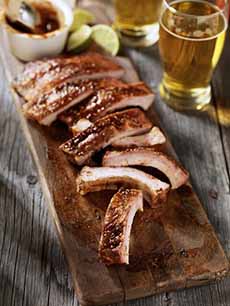
[1] Mustard-glazed spare ribs (photo © Lucero Olive Oil).
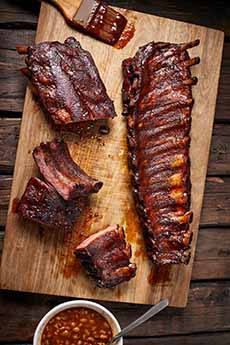
[2] Smoked baby back ribs. Here’s the recipe (photo © Omaha Joe’s).

[3] A rack of spare ribs on the left, baby back ribs on the right(photo © Weber).
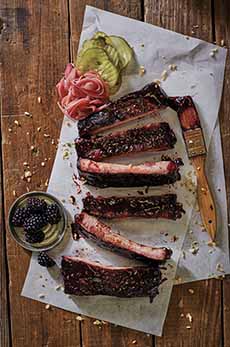
[4] Fruit glazes are popular, from apricot to tropical fruits like mango and pineapple. These are blackberry-glazed spare ribs, made with blackberry fruit spread (photo © Recipe Tin Eats).
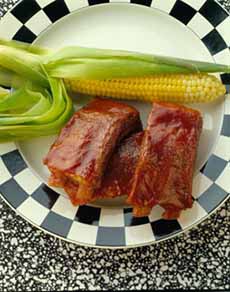
[5] There are two baby back ribs in each of the two pieces on the plate (photo © National Pork Board).
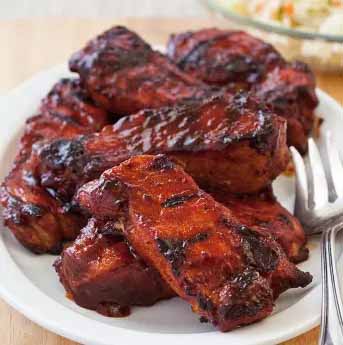
[6] Country-style ribs. Here’s the recipe (photo © Cook’s Country).

[7] The locations of the different cut of ribs (image © Rupari Food Services).
|






